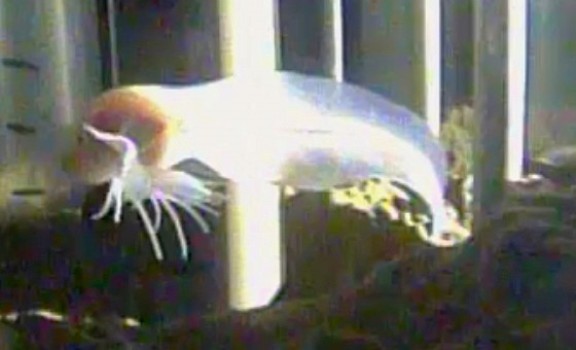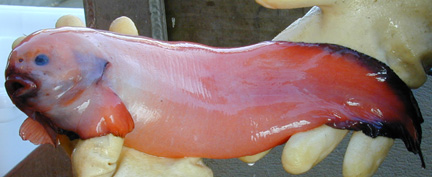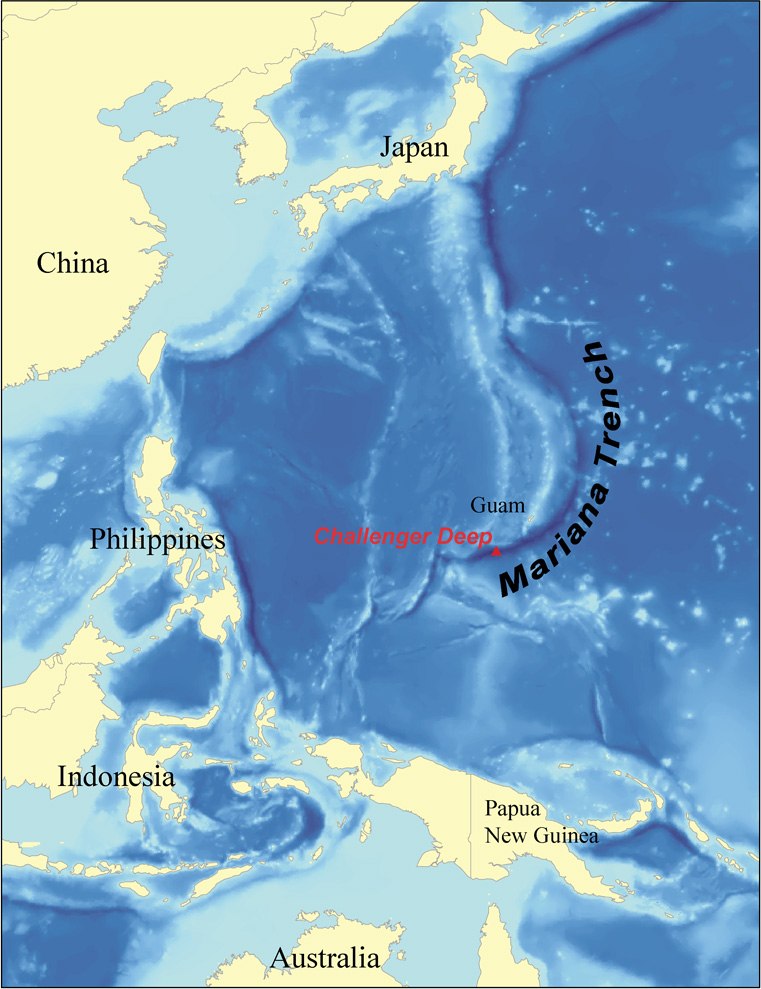The following article is by Whitman College news writer Gina Ohnstad, posted December 19, 2014, and titled “Whitman College professor and students discover new species in the deepest trench on earth”:
The Mariana Trench – located in the Western Pacific near Guam – has been the focus of high-profile voyages to conquer Challenger Deep, the deepest place on Earth. This recent expedition to the Trench onboard Research Vessel Falkor targeted multiple depths and found active thriving communities of animals. The expedition set many new records, including the deepest rock samples ever collected and the discovery of new fish species at the greatest depths ever recorded.
This Hadal Ecosystem Studies (HADES) expedition departed from other deep-sea trench research by sampling a broad spectrum of environments using five deep-sea vehicle systems called landers at specifically targeted depths from 5000 to 10,600 meters (16,404 to 34,777 feet). Rather than solely focusing on the deepest point in the Mariana Trench, a concerted effort was made to gain a better understanding of the interplay between life and geologic processes across the entire hadal zone.
Dr. Jeff Drazen, co-chief scientist, expressed the drive behind this method: “Many studies have rushed to the bottom of the trench, but from an ecological view that is very limiting. It’s like trying to understand a mountain ecosystem by only looking at its summit.” The findings from this research will help to answer important questions about Earth’s largest and least explored habitat, including what organisms live there and how life adapts to these extreme conditions, as well as, how much carbon in the atmosphere reaches the deep sea and if it affects the food chains there.
New species were discovered on this expedition that will provide insight into the physiological adaptations of animals to this high-pressure environment. This research is being conducted in the lab of Whitman College’s Professor of Biology Paul Yancey. In the past, Yancey and his students, working on animals from moderate depths, discovered certain organic molecules that protect the cells of deep-sea animals from the effects of high pressure, which distorts proteins such as enzymes. These kinds of protective molecules are also being tested to treat human diseases that are caused by malformed proteins, such as cystic fibrosis. Additionally, his work on protective molecules in fishes predicted that fish would not be able to live below about 8,200 meters (27,060 feet). Prior to this expedition, the deepest documented fish was from 7,700 meters (25,410 feet).
“In this new research, my students Chloe Weinstock ’17 and Anna Downing ’16 and I want to see if such molecules help animals at the greatest ocean depths – about 35,000 feet in the Mariana Trench,” said Yancey. “In a preliminary analysis of amphipods we got from the Kermadec Trench (33,000 feet deep) last spring, Gemma Wallace ‘14 and I discovered high levels of a potentially protective molecule, scyllo-inositol, that is coincidentally being tested by medical researchers to treat malformed proteins thought to cause Alzheimer’s Disease.”
The expedition also broke several records for the deepest living fish either caught or seen on video. Setting the record at 8,143 meters, (26,872 feet) was a completely unknown variety of snailfish, which stunned scientists when it was filmed several times during seafloor experiments. The white translucent fish had broad wing-like fins and an eel-like tail and slowly glided over the bottom. Additionally, the deepest rock samples ever obtained from the inner slope of the Trench represent some of the earliest volcanic eruptions of the Mariana Island arc. These rocks can provide significant information on the geology of the trench system.
Wendy Schmidt, co-founder and vice president of the Schmidt Ocean Institute, was delighted with the success of the expedition. “Rarely do we get a full perspective of the ocean’s unique deep environments. The questions that the scientists will be able to answer following this cruise will pave the way for a better understanding of the deep sea, which is not exempt from human impact.”
Falkor is now back in the Mariana Trench conducting research that will complement the previous expedition and continue to explore this unique environment. For the latest findings and updates, check the Schmidt Ocean Institute website at www.schmidtocean.org. Additional information about the HADES program can be found at www.whoi.edu/hades.




_by-RaBoe.jpg)

